As the glass plate mystery deepens the studio and interior photos made by the unidentified photographer may hold some clues to his identity and story. There is one very big clue that I will show last, but first, here are some of the best and most skillfully made images by the phantom.
In these three studio portraits it’s clear that our photographer understands how to manipulate light and use reflection for emphasis. At first glance the girlfriends picture is playful and cleaver in the way their flowered hats carry over to the two flower vases on the table. But it isn’t particularly polished, the way a professional studio would have been in the late teens. The back screen is too plain and the ragged edge at the bottom almost seems like a hasty, amature setup.
It’s obviously the same guy in the next two portraits posing in costumes. The WW1 military tunic and hat suggest a post war date after November 1918. In both photos a movable reflective screen is visible on the right side suggesting a window for natural light on the left. Same quality problem with the bottom of the backdrop and under the soldier’s feet is a partial rug that doesn’t completely cover a rough plank floor. My sense is the setup is not in a professional photographer’s studio at all. Maybe our image maker is portable and door to door in the service he sells. Might also mean that his business may not show up in a city directory or business ad.
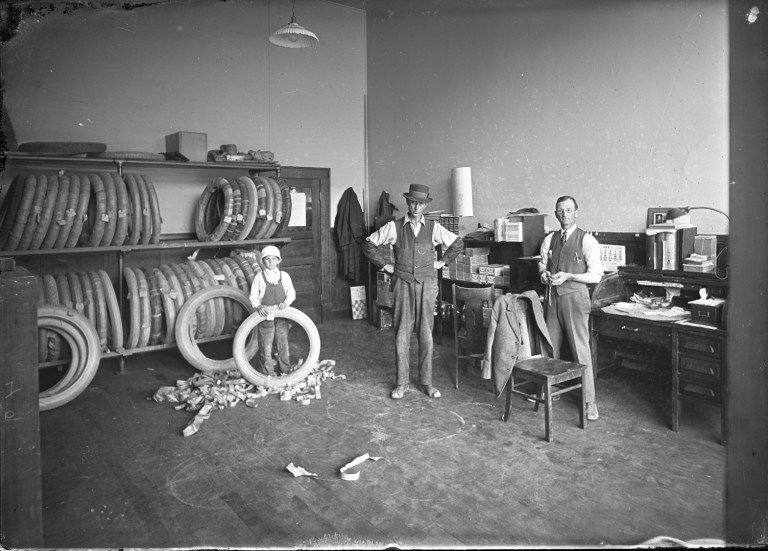
Without a formal studio or business address it makes sense that he is resourceful in the use of available light. Here is the interior of a sparse tire store somewhere, tires on the rack and inner tubes in boxes on the shelves. There is a reoccurring detail in the collection that you can see here. They tend to record small businesses, working class people and children, which implies families that don’t have household staff or upper class wealth. Most of the pictures are also taken in summertime when daylight was strong, business seemed good and an itinerant photographer could travel. The desk calender says July and the boy is out of school at work with his dad. Maybe the photographer only works in summer-a school teacher maybe?
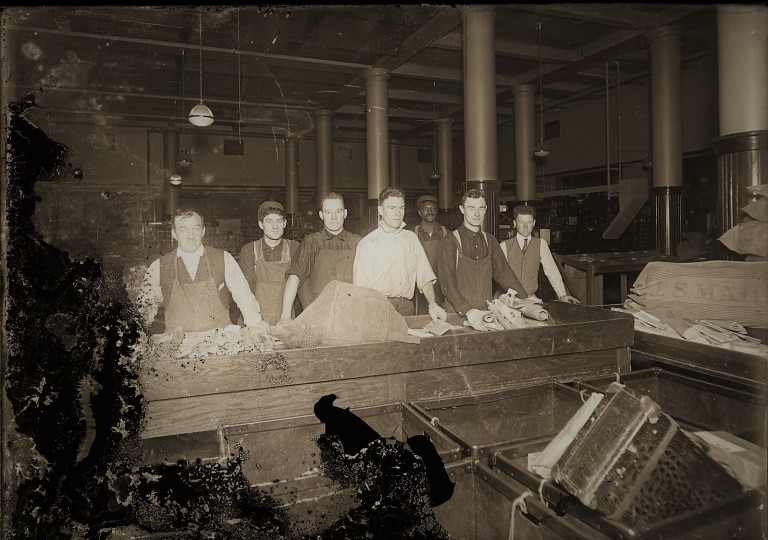
Good chance that this is the downtown Tacoma Post Office and these are the lower level mail handlers. Lighting would have been tricky and the play of light suggests a flash powder bar was used in the windowless basement. The wonderful details in this glass plate negatives and the next are fascinating. Tacoma’s black population was small in the teens and twenties with almost all African Americans working for the railroad or its clients. Seeing the black postal worker included in the photo makes this an unusual document.
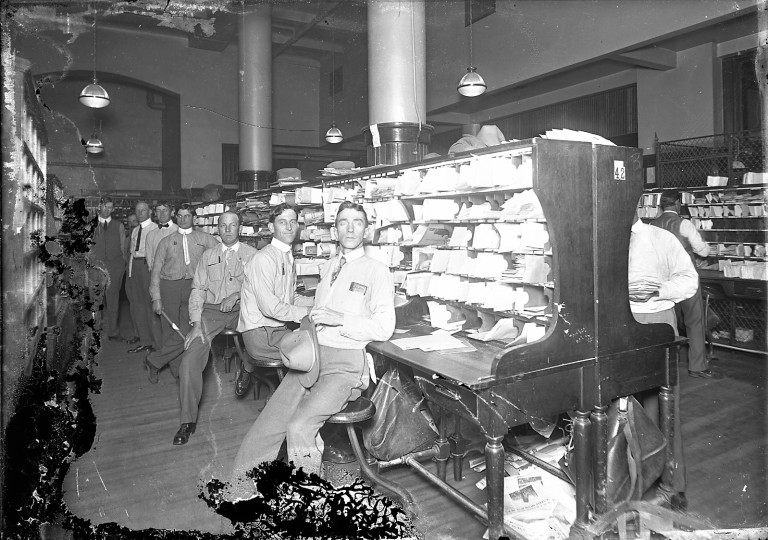
This image probably comes from the same place and time as the last. These workers are on the public floor of the post office public mailboxes on the left and sorting desks to the right. These were white collar workers, literally. All men at the post office, most probably vets from the First World War that were given preference in Federal jobs. No clues to the mystery though.
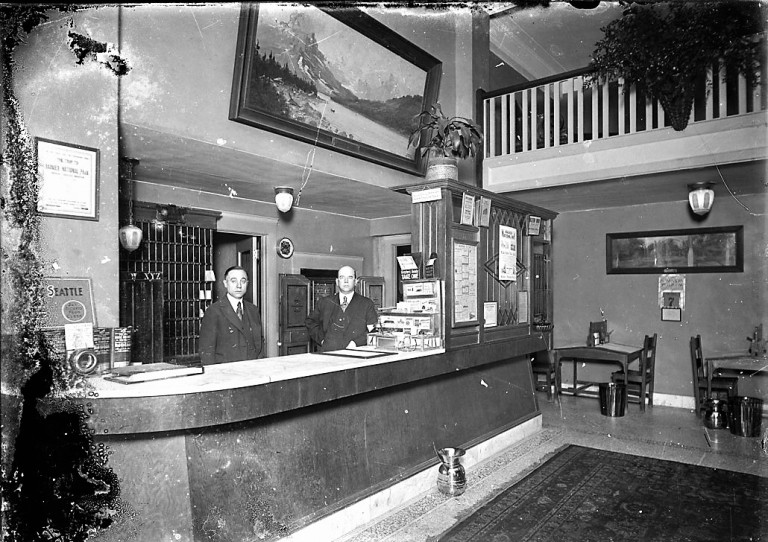
And here is a small but classy hotel lobby in Tacoma or perhaps Puyallup. Tickets to Seattle and Mt. Rainier National Park are advertised on the counter and wall. The terrazzo floor and expensive oriental rug go with the potted plants and oak framed landscape paintings. Spitunes were more acceptable when highly polished. Frustratingly, there is no hotel name visible and consequently no new clue to the photographer.
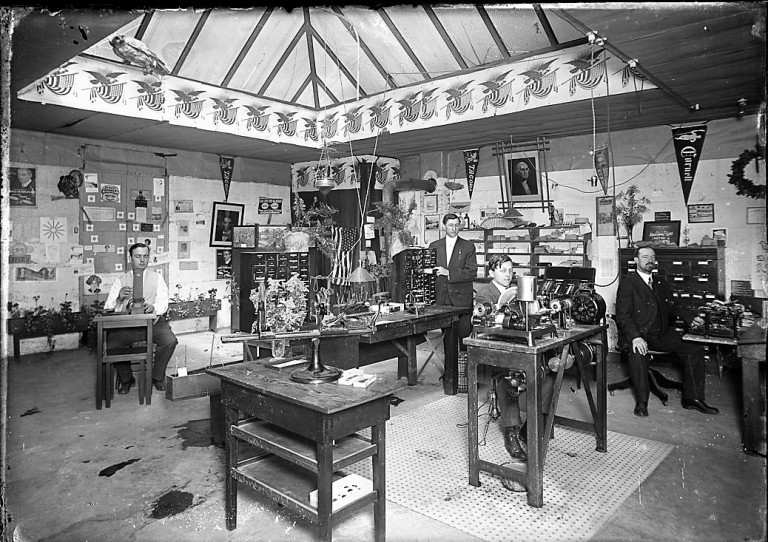
This photo amazes me just for the lighting, geometric composition and busy detail even though I have not figured out what these guys are making or doing. The patriotic banners and flag might be related to a World War One setting the date somewhere around 1917-1918. Tacoma pendants hang on the wall and the luminous skylight and complicated desk machinery look like some kind of printing operation. This image is full of information but no obvious clues. Just a great eye dazzling photograph by someone who knew how to release a shutter.
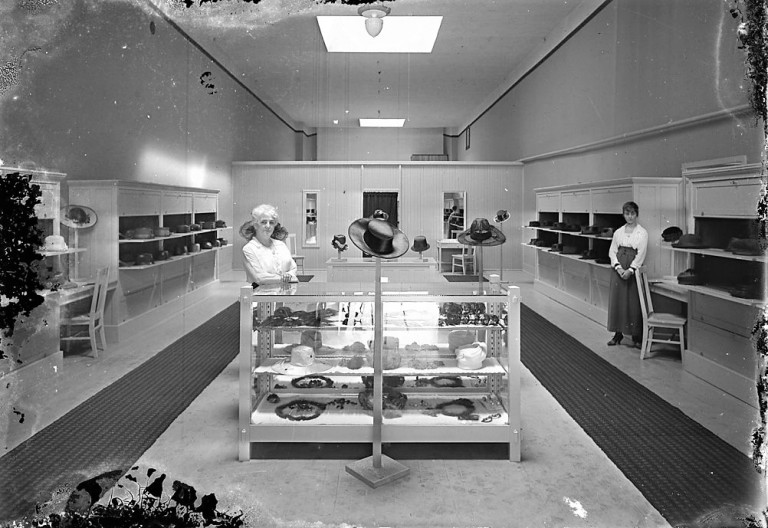
And in its clean light and strict symmetry this image of a ladies hat shop is a perfect contrast to the last. It is startling in its fashionable formality. Modern and minimal in its aesthetic. More than any of the other image in the glass plate negative collection, this photograph displays the work of an artist. Whoever our photographer is, this is his spellbinder–like Edward Hopper’s Nighthawks.
And finally this last interior portrait of a man color tinting a paper print made from a glass plate negative. The light sensitive silver emulsion applied to glass plates recorded pure white light resulting in clear black and white images. Before the invention of color film the way photographers brough natural color to their work was to apply it by hand as a watercolor. In the professional studios, specialists were hired to hand tint the photographic prints. In the small shops the photographer did the tinting. In its perfect lighting and staged studio composition the shutter might well have been on a timer so the photographer could become the photographed figure. This might be a first look at the elusive image maker we have been searching for but until the next episode he will remain nameless and faceless….
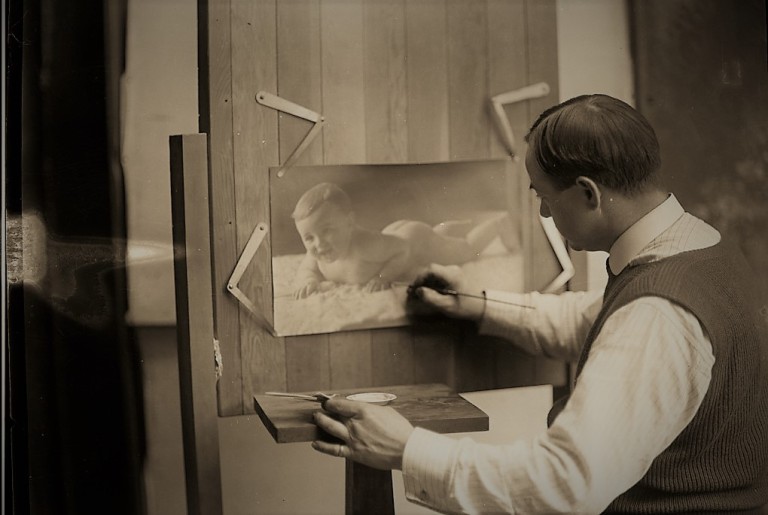
More to come……
For previous episodes…..Clear as Glass and Clear as Glass, Part II
Thanks to Ed Nolan at the Washington State Historical Society Research Center and the Tacoma Public Library for help with this project.




Very inteteresting! What size plates are these negatives? You may be interested to know there is a guy still making dry plate glass negatives you can find on Etsy. I’ve shot with them a couple times and they are definitely fun to play with.
LikeLike
any chance you can post these as higher resolution and that we can click and zoom on them? we might be able to see more details!
LikeLiked by 1 person
What an interesting variety of photos. I love the last photo – didn’t know they did hand-tinting this way.
LikeLike
good article
LikeLike
The photographer may simply be hand re-touching rather than color tinting. Since he only has one small dish of pigment. I’ve done this before on B/W prints where there was a lint mark or small white spot caused by dust on the negative or equipment when making the print. Painstaking work using a tiny brush with only a couple bristles, and lightly “tapping” to fill in the spot with tiny “dots” of pigment to emulate the film/paper grain and cover the blemish.
LikeLike
I also noticed in the first Post Office photo, that the photographers CASE appears to be in the lower right corner sitting partly in the parcel bin, but the view is of the back/bottom side without the stickers that have been visible on the “front” side in other photos. 🙂
LikeLike